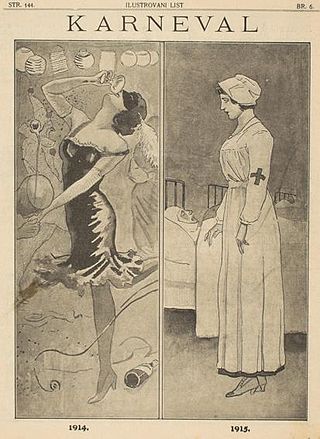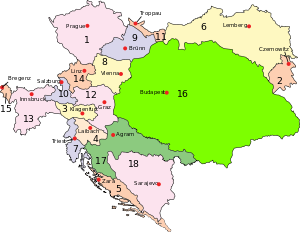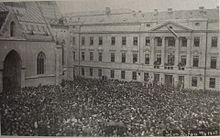
The State of Slovenes, Croats and Serbs was a political entity that was constituted in October 1918, at the end of World War I, by Slovenes, Croats and Serbs (Prečani) residing in what were the southernmost parts of the Austro-Hungarian Empire. Although internationally unrecognised, this was the first incarnation of a Yugoslav state founded on the Pan-Slavic ideology. Thirty-three days after it was proclaimed, the state joined the Kingdom of Serbia and the Kingdom of Montenegro to form the Kingdom of Serbs, Croats and Slovenes.

The Corfu Declaration was an agreement between the prime minister of Serbia, Nikola Pašić, and the president of the Yugoslav Committee, Ante Trumbić, concluded on the Greek island of Corfu on 20 July 1917. Its purpose was to establish the method of unifying a future common state of the South Slavs living in Serbia, Montenegro and Austria-Hungary after the First World War. Russia's decision to withdraw diplomatic support for Serbia following the February Revolution, as well as the Yugoslav Committee's sidelining by the trialist reform initiatives launched in Austria-Hungary, motivated both sides to attempt to reach an agreement.

The Yugoslav Committee was a World War I-era unelected, ad-hoc committee largely consisting of émigré Croat, Slovene, and Bosnian Serb politicians and political activists, whose aim was the detachment of Austro-Hungarian lands inhabited by the South Slavs and unification of those lands with the Kingdom of Serbia. The group was formally established in 1915, and it last met in 1919, shortly after the breakup of Austria-Hungary and the establishment of the Kingdom of Serbs, Croats and Slovenes. The Yugoslav Committee was led by the Croat lawyer Ante Trumbić as the committee president, and Croat politician Frano Supilo as its vice president.

Ante Trumbić was a Yugoslav and Croatian lawyer and politician in the early 20th century.

The Lands of the Crown of Saint Stephen, informally Transleithania, were the Hungarian territories of Austria-Hungary, throughout the latter's entire existence, and which disintegrated following its dissolution. The name referenced the historic coronation crown of Hungary, known as the Crown of Saint Stephen of Hungary, which had a symbolic importance to the Kingdom of Hungary.

Yugoslavia was a state concept among the South Slavic intelligentsia and later popular masses from the 19th to early 20th centuries that culminated in its realization after the 1918 collapse of Austria-Hungary at the end of World War I and the formation of the Kingdom of Serbs, Croats and Slovenes. However, the kingdom was better known colloquially as Yugoslavia ; in 1929 it was formally renamed the "Kingdom of Yugoslavia".
The Croat-Serb Coalition was a major political alliance in Austria-Hungary during early 20th century that governed the Croatian lands, the crownlands of Croatia-Slavonia and Dalmatia. It represented the political idea of a cooperation of Croats and Serbs in Austria-Hungary for mutual benefit. Its main leaders were, at first Frano Supilo and Svetozar Pribićević, then Pribićević alone.

Yugoslavism, Yugoslavdom, or Yugoslav nationalism is an ideology supporting the notion that the South Slavs, namely the Bosniaks, Croats, Macedonians, Montenegrins, Serbs and Slovenes, but also Bulgarians, belong to a single Yugoslav nation separated by diverging historical circumstances, forms of speech, and religious divides. During the interwar period, Yugoslavism became predominant in, and then the official ideology of the Kingdom of Yugoslavia. There were two major forms of Yugoslavism in the period: the regime favoured integral Yugoslavism promoting unitarism, centralisation, and unification of the country's ethnic groups into a single Yugoslav nation, by coercion if necessary. The approach was also applied to languages spoken in the Kingdom. The main alternative was federalist Yugoslavism which advocated the autonomy of the historical lands in the form of a federation and gradual unification without outside pressure. Both agreed on the concept of National Oneness developed as an expression of the strategic alliance of South Slavs in Austria-Hungary in the early 20th century. The concept was meant as a notion that the South Slavs belong to a single "race", were of "one blood", and had shared language. It was considered neutral regarding the choice of centralism or federalism.

The May Declaration was a manifesto of political demands for unification of South Slav-inhabited territories within Austria-Hungary put forward to the Imperial Council in Vienna on 30 May 1917. It was authored by Anton Korošec, the leader of the Slovene People's Party. The document was signed by Korošec and thirty-two other council delegates representing South-Slavic lands within the Cisleithanian part of the dual monarchy – the Slovene Lands, the Dalmatia, Istria, and the Condominium of Bosnia and Herzegovina. The delegates who signed the declaration were known as the Yugoslav Club.

The National Council of Slovenes, Croats and Serbs was a group of political representatives of South Slavs living in Austria-Hungary and subsequently in the short-lived State of Slovenes, Croats and Serbs formed in the wake of dissolution of Austria-Hungary. It was established in Zagreb on 8 October 1918, largely composed of members of various representative bodies operating in Habsburg crown lands inhabited by South Slavs. Founding of the National Council was fulfilment of the Zagreb Resolution on concentration of South Slavic political forces adopted earlier that year on the initiative of the Yugoslav Club. The council elected its central committee and the presidency led by Anton Korošec as the president and by Svetozar Pribičević and Ante Pavelić as vice-presidents.

In the history of Austria-Hungary, trialism was the political movement that aimed to reorganize the bipartite Empire into a tripartite one, creating a Croatian state equal in status to Austria and Hungary. Franz Ferdinand promoted trialism before his assassination in 1914 to prevent the Empire from being ripped apart by Slavic dissent. The Empire would be restructured three ways instead of two, with the Slavic element given representation at the highest levels equivalent to what Austria and Hungary had at the time. Serbians saw this as a threat to their dream of a new state of Yugoslavia. Hungarian leaders had a predominant voice in imperial circles and strongly rejected Trialism because it would liberate many of their minorities from Hungarian rule they considered oppressive.

The Triune Kingdom of Croatia, Slavonia and Dalmatia was part of Austria-Hungary during World War I. Its territory was administratively divided between the Austrian and Hungarian parts of the empire; Međimurje and Baranja were in the Hungarian part (Transleithania), the Kingdom of Croatia-Slavonia was a separate entity associated with the Hungarian Kingdom, Dalmatia and Istria were in the Austrian part (Cisleithania), while the town of Rijeka had semi-autonomous status.
The armistice of Belgrade was an agreement on the termination of World War I hostilities between the Triple Entente and the Kingdom of Hungary concluded in Belgrade on 13 November 1918. It was largely negotiated by General Louis Franchet d'Espèrey, as the commanding officer of the Allied Army of the Orient, and Hungarian Prime Minister Mihály Károlyi, on 7 November. It was signed by General Paul Prosper Henrys and vojvoda Živojin Mišić, as representatives of the Allies, and by the former Hungarian Minister of War, Béla Linder.

The Lipošćak affair was an alleged conspiracy led by the former Austro-Hungarian Army General of the Infantry Anton Lipošćak to seize power in the recently proclaimed State of Slovenes, Croats and Serbs at the end of the First World War. The majority view of the allegations is that they were fabricated by allies of the Croat-Serb Coalition leader Svetozar Pribičević. Lipošćak was arrested on 22 November 1918 under suspicion of treason. He was accused of plotting to establish councils composed of workers, peasants and soldiers in place of the existing authorities with the aim of reviving the Habsburg monarchy, or working on behalf of foreign powers or the Bolsheviks.

The Geneva Declaration, Geneva Agreement, or Geneva Pact was a statement of political agreement on the provisional political system in the future union of the South Slavs living in the territories of the former Austro-Hungarian Empire and Kingdom of Serbia. It was agreed by Serbian Prime Minister Nikola Pašić on behalf of Serbia, representatives of Serbian parliamentary opposition, representatives of the National Council of the State of Slovenes, Croats and Serbs which recently seceded from Austria-Hungary, and representatives of the Yugoslav Committee. The talks held in Geneva, Switzerland on 6–9 November 1918 built upon and were intended to supersede the 1917 Corfu Declaration agreed by Pašić and Yugoslav Committee president Ante Trumbić. The basis for the talks was provided by the Greek Prime Minister Eleftherios Venizelos on behalf of the Supreme War Council of the Triple Entente. The talks were necessary in the process of creation of Yugoslavia as a means to demonstrate to the Entente powers that various governments and interests groups could cooperate on the project to establish a viable state.

Anton Lipošćak, was an Austro-Hungarian Army General of the Infantry of Croatian descent who served as the Governor-General of the Military Government of Lublin during the World War I. After the war, Lipošćak returned to Zagreb where the State of Slovenes, Croats and Serbs declared independence from Austria-Hungary. He was accused of plotting a coup d'état and arrested. Most present-day sources consider the charges false. The charges were dropped and Lipošćak released in two months, in early 1919.
The Zagreb Resolution was a political declaration on the need for political unification of the Croats, the Slovenes and the Serbs living in Austria-Hungary. It was adopted by representatives of opposition political parties in the Kingdom of Croatia-Slavonia presided by Ante Pavelić in a meeting held in Zagreb on 2–3 March 1918. The declaration relied on the right of self-determination and called for establishment of an independent democratic state respecting rights of individuals and historically established polities joining the political union. It also called for ensuring cultural and religious equality in such a union. The Zagreb Resolution established a preparatory committee tasked with establishment of the National Council of Slovenes, Croats and Serbs intended to implement the resolution. The National Council was established on 5 October in proceedings described by Pavelić as a continuation of the Zagreb conference that March.

On 5 December 1918, the National Guards and Sokol volunteers suppressed a protest and engaged in a armed clash against the soldiers of the 25th Regiment of the Royal Croatian Home Guard and the 53rd Regiment of the former Austro-Hungarian Common Army on 5 December 1918, four days after the proclamation of the Kingdom of Serbs, Croats and Slovenes. National Guardsmen stopped the soldiers at the Ban Jelačić Square in Zagreb.

In the immediate aftermath of World War I, the region of Međimurje was occupied by forces loyal to the National Council of the State of Slovenes, Croats and Serbs, one of the predecessor states to the Kingdom of Yugoslavia, in November and December 1918. Predominantly inhabited by Croats, this territory was a part of the Kingdom of Hungary until it was captured by Yugoslav forces. The region was annexed by Yugoslavia, which was awarded it at the Paris Peace Conference (1919–1920).

The 1920 Croatian Peasant Rebellion, which is also known as the Križ Republic occurred from 4 to 12 September 1920 in the countryside north-west and west of Zagreb in the recently established Kingdom of Serbs, Croats and Slovenes. The rebellion, which centred around the town of Križ, was the result of predominantly economic grievances and resistance to conscription in Croatia-Slavonia. The immediate cause of the revolt was a campaign by the Royal Yugoslav Army, which was tasked with maintenance of public order in the area after the end of World War I, to register and brand draft animals for military use.





















